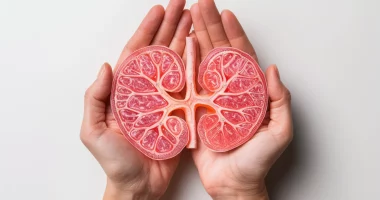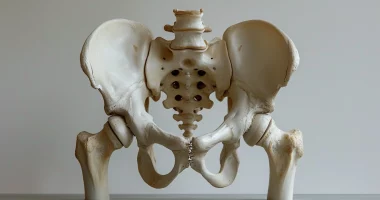Hepatitis D
What is hepatitis D?
Hepatitis D is a liver pathology of an inflammatory nature, which occurs due to the damaging effect on hepatocytes of the same name virus – hepatitis D virus. It is not an independent disease – it always occurs in combination with hepatitis B, aggravating the pathological process caused by it and increasing the risk of complications.
An essential role in diagnosis is played by vigilance regarding the possibility of hepatitis D in persons with hepatitis B, combined with quality laboratory and instrumental studies that allow timely verification of infection.
About the disease
According to WHO, viral hepatitis D affects about 5% of people infected with hepatitis B, which is about 15-20 million. The majority of those infected are adults.
Without hepatitis B in the body, the hepatitis D virus cannot exist. This infectious agent is a defective RNA virus – it does not have its own membrane and enzymes necessary for reproduction, and hepatitis B antigen is required for its replication.
Hepatitis D virus has a direct cytopathic action – it damages the hepatocytes themselves, disrupting their work, unlike hepatitis B, where the liver cells containing the virus suffer from the immune system’s attempts to destroy them. That is why B + D infection is severe and leads to rapid development of cirrhosis, liver failure, and liver cancer.
Types
According to the peculiarities of the clinical course, distinguish acute and chronic viral hepatitis D.
Depending on the moment of infection in relation to hepatitis B are distinguished:
- co-infection (the patient becomes infected with two types of hepatitis virus at the same time);
- superinfection (hepatitis D virus enters the body of a patient who already has hepatitis B).
Symptoms
Signs of hepatitis D are not radically different from the manifestations of other variants of liver inflammation. Patients present with complaints of:
- general weakness, fatigue, irritability, and sleep disturbance;
- decreased appetite, nausea;
- varying degrees of yellowing of the skin, visible mucous membranes, sclerae;
- episodic elevation of body temperature;
- volatile joint pain;
- dark urine, light-colored feces;
- itchy skin;
- discomfort and heaviness in the right subcostal region;
- in severe, neglected cases, there are weight loss, swelling, and an increase in the size of the abdomen due to fluid accumulated in the abdominal cavity.
Co-infection with hepatitis B and D viruses often proceeds in the form of moderate to severe acute inflammation of the liver, in the vast majority of cases, ends with complete recovery of the patient, and only one person in 20 leads to the development of chronic hepatitis D.
Superinfection of this virus is characterized by a vivid clinical symptomatology of the disease. The condition of a patient suffering from hepatitis B, when infected with the hepatitis D virus, sharply markedly worsens – the symptoms of the disease increase, and the structure of the liver is violated rapidly.
Reasons
The cause of both acute and chronic hepatitis D is a virus of the same name that has entered the patient’s body. The infection is carried with contaminated blood. The main mechanisms of transmission are:
- non-medical manipulation with insufficiently sterile instruments (during manicures, piercings, tattoos, injecting drugs with the same needle);
- medical manipulations, operations with non-compliance with the rules of asepsis and antisepsis;
- transfusion of donor blood that has not been adequately tested for infections;
- household items (shared toothbrush, razor);
- indiscriminate sexual intercourse, especially with increased risk of genital tract trauma (predominantly in homosexual male couples or sex workers);
- from an infected mother to an infant transplacentally or during delivery if there has been trauma to the genital tract and contact between the mother’s blood and the fetus’s blood.
Diagnosis
A competent general practitioner, infectious disease specialist, gastroenterologist, or hepatologist knows that a patient suffering from hepatitis B has a high risk of infection with hepatitis D, and if there are changes in the person’s condition, the patient will necessarily be examined for this infection.
Objectively, in the presence of inflammation of the liver, not only this, but any other etiology, the doctor will find an increase in the size of the liver and possibly the spleen, change in the color of the palms (redness), vascular stars on the skin, changing its shade to yellow, the presence of traces of scratching from incessant skin itching.
Verify the causative agent of the infection specialist will help enzyme-linked immunosorbent assay (ELISA), which will detect antibodies to the hepatitis D virus – immunoglobulins of class G (indicating that the body is familiar with the infection, met with it previously) and M (a sign of the acute phase of the pathological process). Confirm the diagnosis with a probability of 100% PCR blood test for hepatitis D, which allows you to find in the biomaterial under study genetic material (RNA) of the virus – the causative agent of the disease. PCR can determine both the presence of the virus (qualitative analysis) and its concentration or viral load (quantitative analysis).
Determine the activity of the inflammatory process and the degree of liver damage will help:
- Biochemical blood test (focus on liver enzymes);
- Ultrasound of abdominal and retroperitoneal organs (hepato- and splenomegaly);
- MRI and/or liver biopsy if necessary.
Treatment
The leading treatment for hepatitis D is long-term antiviral therapy with pegylated interferon-α. Regardless of the dynamics of laboratory parameters and the patient’s well-being, it is necessary to take treatment for at least a year. Ifremission or recovery does not occur after this period, the course of therapy is prolonged.
In some patients, taking this drug is associated with several side effects, which creates difficulties in the therapy of these categories of hepatitis D patients.
In complex treatment, the patient will undoubtedly be prescribed drugs that improve liver function (hepatoprotective drugs), vitamins, sorbents, and infusion drugs for detoxification. Severe forms of inflammation may require surgical intervention in the scope of liver transplantation.
During the entire period of therapy and after its completion, the patient is categorically contraindicated to consume alcohol.
All these treatment options are available in more than 150 hospitals worldwide (https://doctor.global/results/diseases/chronic-viral-hepatitis). For example, liver transplantation can be done in 14 clinics across Germany (https://doctor.global/results/europe/germany/all-cities/all-specializations/procedures/liver-transplantation).
Prevention
The primary preventive measure against hepatitis D is the prevention of hepatitis B virus infection by vaccination. It is essential to thoroughly test donated blood for infections, sterilize medical and disposable instruments used for cosmetic procedures, and practice protected sex with a trusted sexual partner. You should also lead a healthy lifestyle, minimize stress, eat a balanced diet, and observe the rules of personal hygiene.
Rehabilitation
Patients suffering from hepatitis D are subject to dispensary observation with a general practitioner, gastroenterologist, hepatologist, or infectious disease specialist (in case of acute form of the disease). Periodically, they visit a specialist for examination, take the necessary minimum of tests to assess the dynamics of the pathological process, detect alarming changes, and adjust the therapy.



